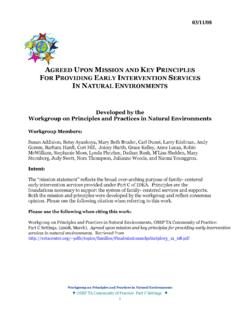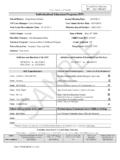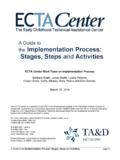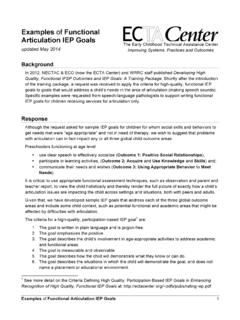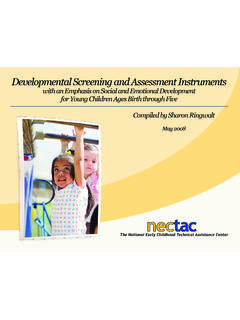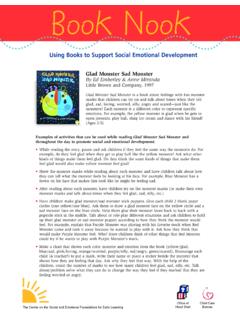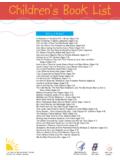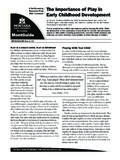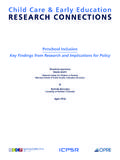Transcription of Key PRINCIPLES of Early Intervention and Effective ...
1 Wendy Whipple, Program Specialist With Support from the RRCP, Early Childhood Service Delivery Priority Team 2014 KEY PRINCIPLES OF Early Intervention AND Effective PRACTICES: A CROSSWALK WITH STATEMENTS FROM DISCIPLINE SPECIFIC LITERATURE 1 | Page December 2014 Many states have been evaluating their Early Intervention practices and undergoing system change to incorporate Effective practices related to providing services within the natural environment, as well as implementing a primary service provider approach based on the family and child s needs. This document provides a crosswalk that illustrates Effective Early Intervention practices and relevant statements from disciplines providing Early Intervention services. This document highlights how position statements, resources and literature of various professions working in Early Intervention supports the Early Intervention key PRINCIPLES and reflects how these professions services align with high quality Early Intervention practices.
2 It is intended to promote dialogue within the Early childhood community about the key PRINCIPLES and provision of high quality Early Intervention services, which each profession provides within their profession s scope of practice. The starting point for this document was the AGREED UPON PRACTICES FOR PROVIDING Early Intervention SERVICES IN NATURAL ENVIRONMENTS document, which includes practices that support the key PRINCIPLES of providing Early Intervention services in natural environments. The document, developed by the Workgroup on PRINCIPLES and Practices in Natural Environments, reflects practices validated through research, model demonstration, and outreach projects implemented by workgroup members. The document includes the consensus opinions of the workgroup members, who avoided endorsing any specific model or approach. The national workgroup included Susan Addision, Betsy Ayankoya, Mary Beth Bruder, Carl Dunst, Larry Edelman, Andy Gomm, Barbara Hanft, Cori Hill, Joicey Hurth, Grace Kelley, Anne Lucas, Robin McWilliam, Stephanie Moss, Lynda Pletcher, Dathan Rush, M Lisa Shelden, Mary Steenberg, Judy Swett, Nora Thompson, Julianne Woods, and Naomi Younggren.
3 Citations: Workgroup on PRINCIPLES and Practices in Natural Environments (2007). Agreed upon practices for providing Early Intervention services in natural environments. OSEP TA Community of Practice Part C Settings. Agreed upon Practices for Providing Early Intervention Services in Natural Environments Workgroup on PRINCIPLES and Practices in Natural Environments (February 2008). Seven key PRINCIPLES : Looks like/doesn t look like. OSEP TA Community of Practice Part C Settings. Seven Key PRINCIPLES : Looks Like/Doesn't Look like The PRINCIPLES identified in this document were cross walked with statements from the literature, position statements, and/or resources of the professional organizations that provide support to Early Intervention services including: American Association on Intellectual and Developmental Disabilities (AAIDD) American Academy of Pediatrics (AAP) Division of Early Childhood of the Council for Exceptional Children (DEC) National Association for the Education of Young Children (NAEYC) National Association of School Psychologists (NASP) American Speech-Language-Hearing Association (ASHA) American Occupational Therapy Association (AOTA) American Physical Therapy Association (APTA) 2 | Page December 2014 States may find this document useful for reviewing the agreed upon practices across all disciplines.
4 In some instances the literature may use different terms to refer to practices. This document reflects statements from the literature, resources, and/or position statements of the various professional organizations, but is not attributing meaning to those statements. References used in developing this publication are included at the end of this document. 3 | Page December 2014 1. Infants and toddlers learn best through everyday experiences and interactions with familiar people in familiar contexts Early Intervention Key PRINCIPLES Supporting Statements from Discipline Specific Literature Learning activities and opportunities must be functional, based on child and family interest and enjoyment Learning is relationship-based Learning should provide opportunities to practice and build upon previously mastered skills Learning occurs through participation in a variety of enjoyable activities AAIDD All young children who are at-risk for or who have been identified with intellectual and/or developmental disabilities should have access to high-quality, affordable developmental services in natural environments.
5 When Early childhood services are provided in natural environments, both children and families will experience increased community inclusion during Early childhood and across the life span. AAP Health care practitioners listen to and honor patient and family perspectives and choices. Patient and family knowledge, values, beliefs, and cultural backgrounds are incorporated into the planning and delivery of care. AOTA Occupational therapy works with children, families, and others to achieve health, well-being, participation in life through active engagement in occupations activities of daily living (ADLs) and instrumental activities of daily living (IADLs) such as education, work, play, leisure, sleep, and social participation. It facilitates the child and family s participation in meaningful occupations that are desired and important in the school, family, and community contexts. Understanding the environments and contexts in which occupations can and do occur provides practitioners with insights into their overarching, underlying, and embedded influences on engagement.
6 ADLs, sensory-based play, and social participation are the foundations for learning, which takes place in the context of relationships. Occupational therapists have expertise to address both mental and physical health in a variety of Early childhood settings. In the neonatal intensive care unit (NICU), Intervention is provided to enhance growth and development for premature or medically fragile infants and build family capacity to care for their child. Occupational therapists who work in Early Intervention programs in clinics, homes, or community settings provide interventions that incorporate individual learning opportunities for children within their natural routine and activities. In all of these environments, occupational therapists collaborate with others to support participation. Occupational therapy practitioners partner with family members and caregivers to promote the child's development by recommending learning opportunities within the family's daily routines.
7 Conversations with the family help occupational therapy practitioners gain a perspective of how the child spends his or her time; what activities the child wants or needs to do; and how the environment in which the child lives, plays, and attends school supports or hinders occupational engagement. Services in the home allow the practitioner to gain a perspective on the family's values, routine, and relationships; consequently, he or she can suggest therapeutic activities that easily fit into the family's daily routine. In home-based services, occupational therapists provide the culturally relevant strategies that match the child s environment and the family's resources. They focus on the child's participation in play and everyday activities, recognizing that children can easily generalize skills when learned and practiced in their natural environment. APTA Natural environments are home (family life) and community-life settings that are natural and typical for children without a disability and their families.
8 Settings where the child, family, and care providers participate in everyday routines and activities that are important to them and serve as important learning opportunities. ASHA Services are developmentally supportive and promote children's participation in their natural environments. Early speech and language skills are acquired and used primarily for communicating during social interactions. 4 | Page December 2014 o .. Intervention occurring within the child's and family's functional and meaningful routines. o .. services and supports including speech-language and audiology treatment are provided in the locations where the families typically spend their time. Children learn through participating in their everyday activities and meaningful experiences with their family and caregivers. DEC / NAEYC Providing access to a wide range of learning opportunities, activities, settings, and environments is a defining feature of high quality Early childhood inclusion.
9 Opportunities for learning in the child s natural settings must be identified including the learning opportunities that occur in those settings. More active involvement of parents in their child s program appears to be related to greater developmental progress. Regular caregivers and regular routines provide the most appropriate opportunities for children s learning and receiving most other interventions . Young children learn through ongoing interactions with their natural environment rather than in isolated lessons or sessions. NASP Early environments matter and nurturing relationships are essential. 5 | Page December 2014 2. All families, with the necessary supports and resources, can enhance their children s learning and development Early Intervention Key PRINCIPLES Supporting Statements from Discipline Specific Literature All means ALL (income levels, racial and cultural backgrounds, educational levels, skill levels, living with varied levels of stress and resources) The consistent adults in a child s life have the greatest influence on learning and development not EI providers All families have strengths and capabilities that can be used to help their child All families are resourceful, but all families do not have equal access to resources Supports (informal and formal)
10 Need to build on strengths and reduce stressors so families are able to engage with their children in mutually enjoyable interactions and activities AAIDD Parental involvement in any program is crucial for success, and Early Intervention is most Effective when the families of children are fully involved. AAP Strong connections within a loving, supportive family, along with opportunities to interact with other children and grow in independence in an environment with appropriate structure, are important assets in a child's life. AOTA The family is assumed to be the constant in the child s life and have the inherent strengths that serve as a foundation for the child s growth and development. Family support strengthens a caregiver or parent s capacity to "captain their own ship" and not become dependent on professionals for all decision making. Client-centered occupational therapy practice supports the perspective that families know their children best, that optimal developmental outcomes occur within a supportive family and community environment, and that each family is unique.
